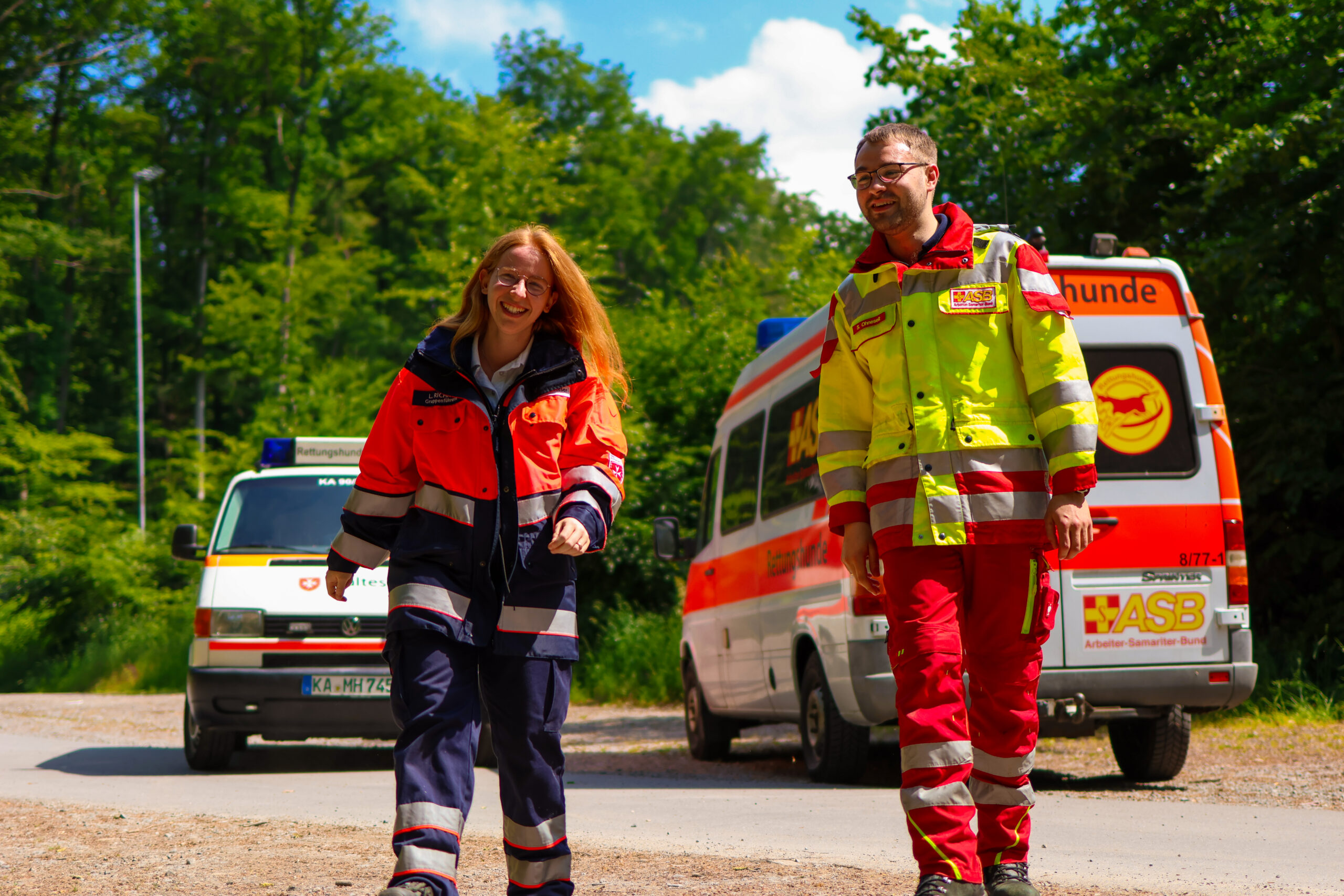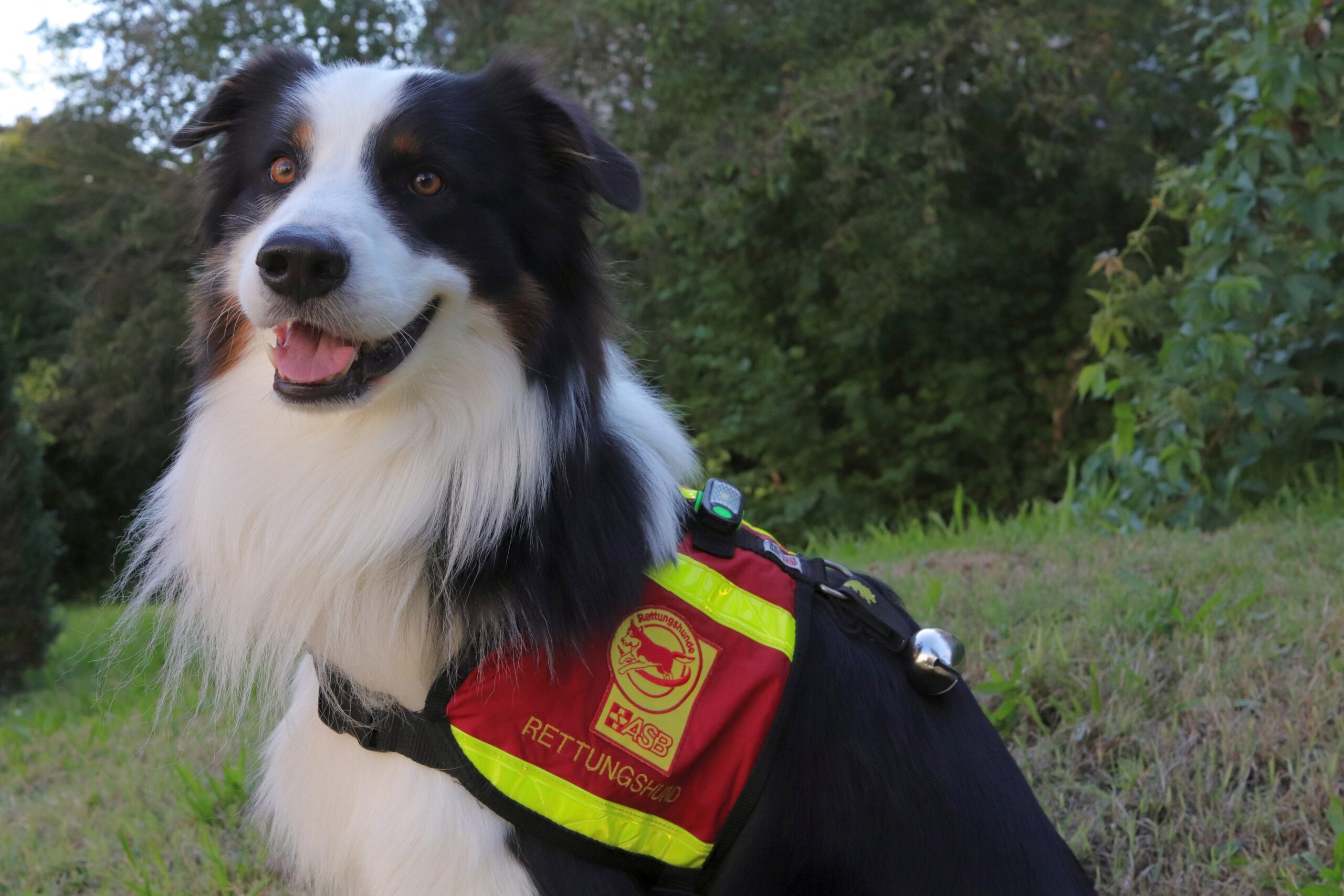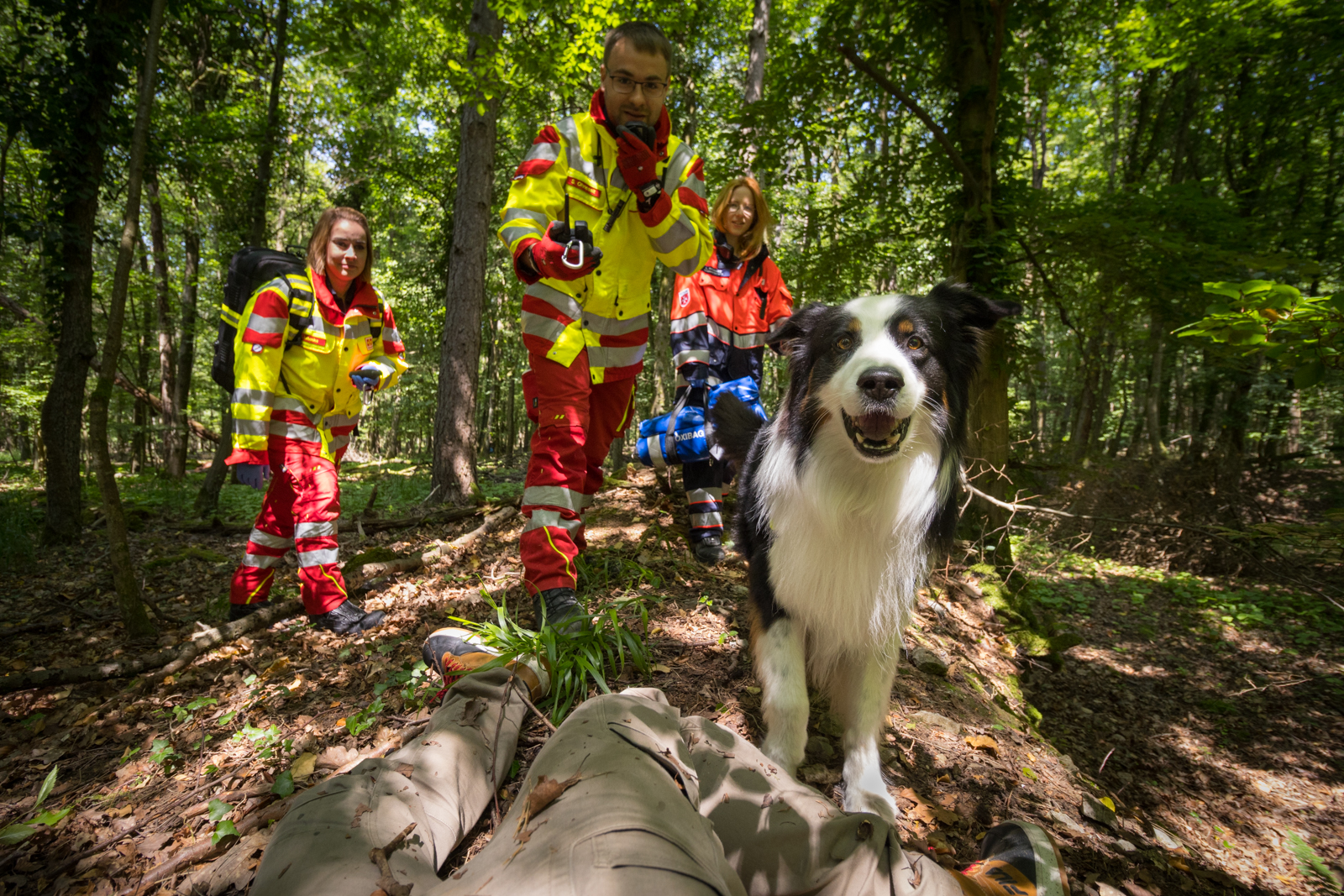19.04.2024 | Bericht
Sebastian Ohneseit – ASB
Today on the line: Sebastian Ohneseit. He can be seen in the winning photo from Karlsruhe. But the real hero of the photo has four paws and an absolutely reliable nose: Australian Shepherd Paul, a rescue dog. Owner and rescue dog handler Sebastian tells us today what he does for a living, how he came to volunteer, why working in the rescue dog unit is something very special – and of course the story behind the photo.

“When an electric car catches fire, I’m thrilled – from a technical point of view!” says Sebastian, 28, a graduate engineer in mechanical engineering and research assistant at the Karlsruhe Institute of Technology. There he conducts research in the field of applied materials on the safety and thermal runaway of lithium-ion batteries and how this can be prevented or controlled. So fires and explosions are a natural part of his day-to-day work. But he didn’t first come into contact with fire as an engineer. He joined the youth fire department at the age of ten. “Unfortunately, I couldn’t do it earlier,” says Sebastian. This voluntary work was his absolute passion right from the start.”
 Love of dogs awakened in the fire department
Love of dogs awakened in the fire department
He also remained loyal to it as an adult. During his studies in Kaiserslautern, he was active in the fire department in the city center and gained operational experience there. The fire department also brought him into contact with his second great passion: working with dogs. His first contact with the rescue dog team was during a search operation as a firefighter: “I was immediately enthusiastic and wanted to join!” Unfortunately, it was difficult to combine a dog with his studies. But as soon as Sebastian started his professional life, he got down to business and signed up to the rescue dog team to take a closer look at the work – but still without a dog. “Normally, you have the dog first and then join the rescue dog team. That’s why I was looked at strangely at first. But I wanted to choose the right dog for the work in the squadron straight away.”
The choice fell on an Australian Shepherd: Paul, the hero of the winning photo.
The dog can do what no technology can
But it was a long journey for Paul to shine, one that the dog and his owner mastered together. There are around a dozen trained rescue dogs throughout Karlsruhe. The demanding training takes two to three years. The reason: “The dog has to work. If we say the section of forest is empty, then no one will search there. We have no room for error. We rely on the dogs’ noses.” A great achievement by the animals and so Paul is quite rightly the focus of the winning photo. Sebastian makes it clear: “Rescue dogs save people’s lives. Our dogs can do something that no technology can. It’s a resource that can’t be replaced.”
Hard training leads to the goal
When you have so much responsibility, you naturally have to train hard. What exactly does Sebastian and Paul’s training schedule look like? “We train for about three hours on Wednesday evenings. And five to seven hours on Saturdays. Then there’s the private training with the dog at home and the commitments for civil protection. Paramedic services, training courses for rescue dog work and civil protection and, of course, missions.” Sebastian became a paramedic in 2020 and a rescue dog trainer in 2022, the same year he took over as head of the rescue dog team. But how exactly does the work of the rescue dog team work? In which areas are the dogs trained?
Sebastian explains: “There are four areas: Water search, mantrailing, area search and debris search. We work in the area search, which mostly takes place in forests and fields.” For example, if a person goes missing, the rescue dog team is alerted by the police and search areas are defined. “And we then plan the most suitable tactics for searching the area. In addition to the topography, the wind direction must also be taken into account, for example, as this is relevant for the dogs to pick up the scent. During its training, the dog has learned to work out the scent particles that it can perceive very well, which every person emits and which are distributed by the wind, and to track them back to the person.
 How did the submitted photo come about?
How did the submitted photo come about?
Sebastian pursues photography as a hobby. During his studies, he took a foreign module on photography in France – and caught fire here too. It’s a good way to combine a hobby and voluntary work: “We regularly take the camera into the field. Simply to be able to show our work. After all, we spend many hours in the forest every week. It’s often easier to explain to friends and family what we’re actually doing with a picture.”
As Sebastian can be seen as the dog guide in the winning photo, he didn’t take the picture himself: “We work very closely with the Malteser Hilfsdienst rescue dog team in training and operations, a cooperation that benefits both sides. We support each other in terms of personnel and can act as managers for the other organization during operations.
As part of this collaboration, we trained a team from the Malteser Hilfsdienst in area searches. A dog guide, who acted as the missing person in this search, took the picture from this perspective.” He continues: “In this picture, I wanted to show the unusual perspective from the point of view of a rescued person, the moment of redemption when help arrives, in this case the ASB and Malteser emergency services. And apparently the idea was so convincing that we made it into the voting with the picture. Further proof that when aid organizations work together, really good things come out of it.”
The hot phase of the voting
Sebastian motivated all social media channels to vote. And his commitment paid off. And not just because the photo was one of the winning photos in the end. Sebastian knew how to use the attention generated by the photo competition and the voting for himself and his animal friends. “When we were told we were in the voting, I immediately wrote to ASB Karlsruhe’s public relations department. Then it got exciting: suddenly the managing director and other full-time staff were involved and I was allowed to report on our rescue dog team.”
All of a sudden, the concentrated attention was focused on the rescue dog work. In addition to ASB Karlsruhe, the regional association posted a story on Tik Tok, while the national association published a post on its Instagram page. Sebastian looks back on the success of the photo competition with satisfaction: “I think that we were able to reach a lot of people with the competition, get them interested in the topic of civil protection and increase their awareness of a particular aspect of it.”
 Can anyone join the dog unit?
Can anyone join the dog unit?
And what if lots of people suddenly want to join the rescue dog team? Is it even something for everyone? Basically yes, says Sebastian. “You have to be physically able to move well in the forest, even cross-country – and not get lost if possible,” he adds with a wink. “The most difficult requirement for us is probably the time required and the work with the dog. The dogs notice immediately if you are nervous or unbalanced – that can make the work much more difficult.” In addition, not everyone is able to devote ten hours a week or more to their voluntary work. But there are other tasks in the rescue dog squadron besides being a dog handler. “You can also join us as a helper without a dog, depending on how much time you have. Or you can support us on the technical side. We can find the right volunteer role for anyone who is interested.”
Volunteering for the whole family
What many volunteers report also applies to Sebastian: Volunteering is also a family affair. His wife is also active in the relay team. They often spend their free time together volunteering. “If you include Paul, the whole family is involved in the dog unit.” And his relay colleagues have also become friends. Volunteering is simply a completely different world to working in the lab – and that is precisely why it is so fulfilling. Sebastian talks about a night-time search mission in a storm last week. During the intensive search under a sky lit up by lightning, there is no room for everyday worries. Sebastian confirms: “You don’t have time to think about upcoming lectures or test series, you’re fully focused on fulfilling the mission in the best possible way.” In addition to balancing work, volunteering is also valuable for another reason: “Volunteering for the blue light really helps you to develop a different perspective, gain skills for life and specialist knowledge.” And it can also get you on the dog.
Sebastian and Paul can be seen with their winning picture in the exhibition “Held:innen von nebenan – Ehrenamtliche im Porträt” in Kiel, Koblenz and Chemnitz.